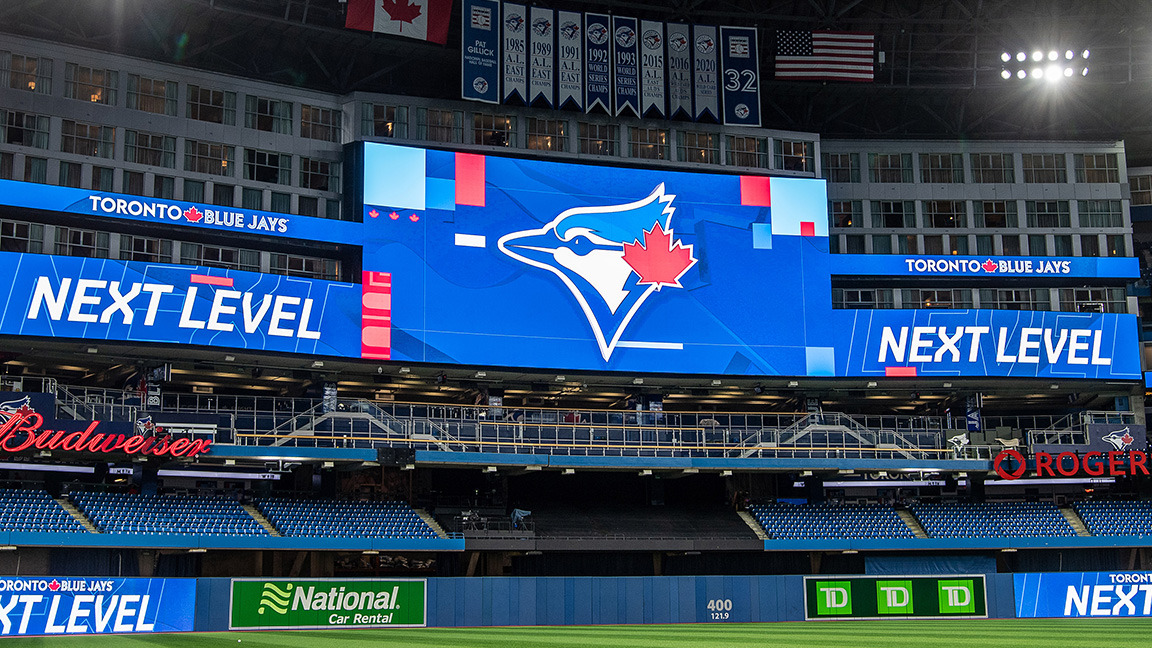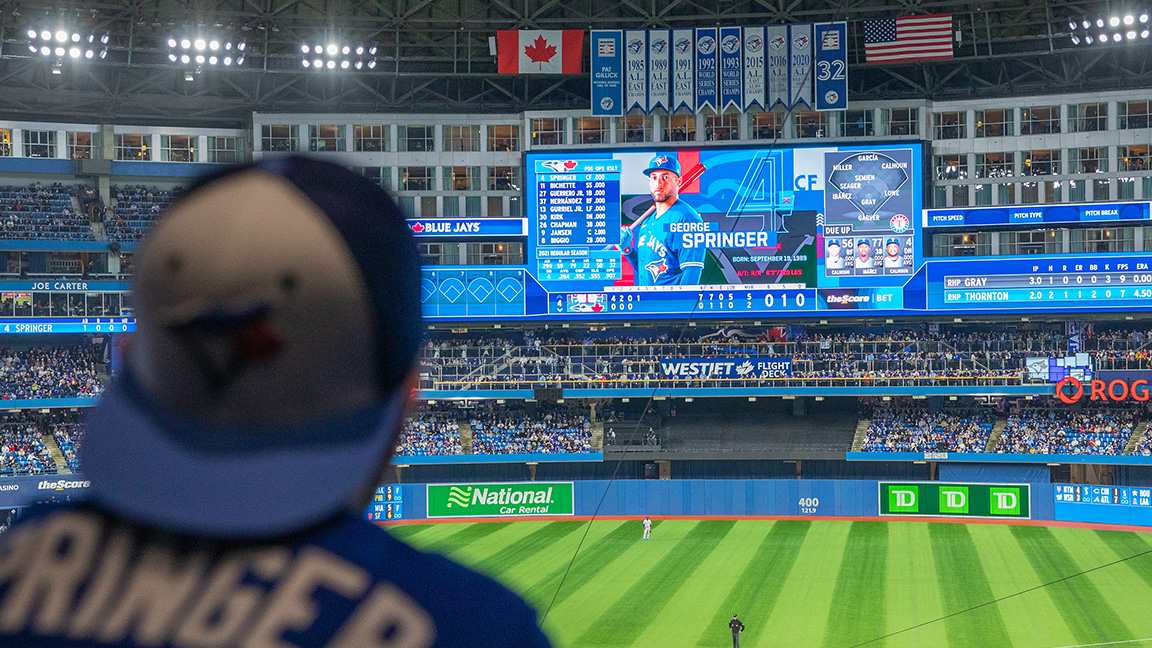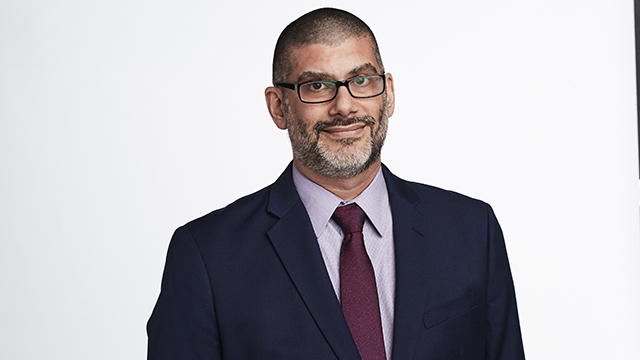Over the past few seasons, the Toronto Blue Jays baseball team has experienced an exciting transition. Younger, fresh players have taken the league by storm and the wins are mounting up. And as the on-field product improved, so did things behind the scenes.
Part of a $200-million budget to renovate the Rogers Centre and surrounding area was focused on the technology in the team’s stadium. With the previous AV upgrades completed circa 2012, it was simply time for a reboot.
“When you get clients like this, to me it’s a special project,” said Michael Martin, director of broadcast services at Anthony James Partners (AJP). “[The Blue Jays] understood that where they were at required a complete overhaul—and they wanted a fresh look.”
[Now Available: Digital Signage Best Practices Guide 2022]
Martin and his team at AJP collaborated with Rogers Communications, which owns the Toronto Blue Jays; however, the finished product was a long time coming. The discussions, plans, and bids began as early as 2018, and when everything looked set to go, the world shut down. The new-look Rogers Centre was put on hold.
The project was back on track around May of 2021. According to Martin, the day after the last game of the 2021 season, the control room went down and the much-anticipated upgrades—including a new LED display system, new video control room, and reinforced, dynamic sound system—were underway.
Centerfield Considerations
The main AV attraction is the Daktronics videoboard in centerfield. It spans 4,873 square feet, nearly 1,400 square feet larger than the previous scoreboard. However, AJP and its team of integrators had the unique challenge of a confined space: There is a hotel in centerfield.
“We were able to work with the design team at AJP to come up with a scoreboard layout that maximizes all the available space in the outfield, considering we are land-locked around a hotel,” said Mike Christiansen, director of technical production and broadcast services for the Toronto Blue Jays. “AJP helped us envision use of the available space in the best possible way through their renders and guidance.”

AJP and its integrators went to work to structurally fit the 10mm pixel pitch, curved HDR videoboard—but there was more work to do in the outfield. Surrounding the main videoboard are two upper ribbons (four foot high and more than 75 feet wide) and two lower ribbons (13.2 feet high and 77 feet wide), which combine five vibrant LED displays into one monster visual experience in centerfield. Now, the Blue Jays content team has multiple zones to bring a wide variety of graphics to its fans, including replay, player stats, and sponsor messaging.
Also new are left and right foul pole displays, left field and right field wall displays (each measuring 10.5 feet by 63.5 feet), and a left and right parapet ribbon board that encircles nearly the entire stadium.
“The technology improvements help with the overall fan experience as we begin to renovate this 30-year-old stadium,” Christiansen said. “After the product on the field, the sound and LED systems are the most noticeable things in the stadium, and doing these massive upgrades shows our fanbase that we are committed to improving their experience at the ballpark.”
Mission Control
The “fresh look” directive was also applied to the video replay control room. While a complete facelift wasn’t required, AJP decided to bring its unique style to the project, adding branding to the control room.
“Any picture of one of our control rooms, you can tell exactly where it’s at,” said Martin. “That’s because of the branding of the countertops, the side modules, and the building itself.”
[Future Proof Control Room Connectivity]
The control room was completely gutted. “Every single table was stripped out; we took it down to the bare core,” Martin recalled. “So, when we say we rebuilt it, when the room was done, it was a brand-new build at that point. It was a total change to the look of the room, but we never changed the layout.”
With the design upgrade in place, AJP worked with Alpha Video and its partner Unity-SI on a new video replay backed by an HDR system. As Martin explained, the Blue Jays are wisely taking their time taking in the new system.
“Next year it will be flipping to HDR,” he said. “That was intentional, [the Blue Jays] wanted to get used to the control room before having to overcome learning HDR. But they are full capable right now—it’s just flipping a switch and creating the content.”
[BeckTV, Ross Video Team Up on New Nerd Street Gamers Broadcast-Quality Esports Facility]
While they stuck with the existing wireless systems, they also added five Sony HDC-3500 cameras, six Sony BRC-X1000 4K PTZ cameras, and a complement of Marshall CV565-MGB POV cameras. “Graphics were the switch,” explained Martin. “They left Chyron and moved over to a Ross Xpression. They have a three-channel Xpression unit as their main CG, but their LED front-end is a full [Biamp] Tesira system, which is running all the front end for the back system.”
Opening Day Comfort
The sound system was also upgraded, including the replacement of all loudspeakers and amplifiers. Now, EAW QX series loudspeakers keep the main seating areas bumping, while QSC Q-SYS processing solutions and amplifiers can be controlled remotely from anywhere in the stadium.
The upgrades were ready to entertain fans with stunning new visuals and sound for Opening Day 2022. “It was a nice smooth transition,” said Martin. “Alpha and Unity up in Canada did such a great job. The whole team worked in a such great collaboration—we did not squeak into the end; we went in comfortably.”
That comfort was the result of a “very proactive team,” according to Martin. “Mike Christiansen and his team made my life easy—from the start to the end, they were a part of the whole project,” he explained. “Nothing was being done that they weren’t a part of the decision. What that does toward the end, is they start learning beforehand. They were training well before the system was built. When the system was ready for a test, they already knew how to run everything, and their graphics guys already had the graphics built. It makes the system come together so smoothly.”
“The relationship with AJP was fundamental to help us through the multi-year process, navigating vendors, contractors, bidding, pricing, and dealing with challenges that come up along the way,” added Christiansen. “It was comforting to have a team of professionals in our corner representing our interests along the way, so we could focus on the other day-to-day work that doesn’t stop during upgrades and construction projects like this. We look forward to using AJP’s services as we move through the rest of the stadium renovations in the next couple of offseasons.”

